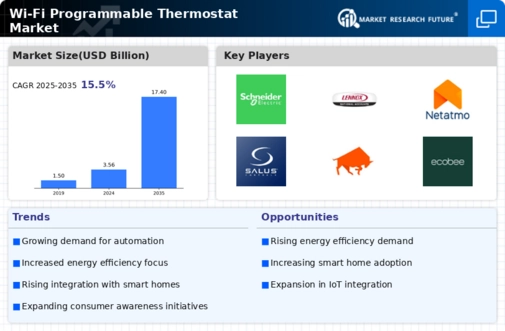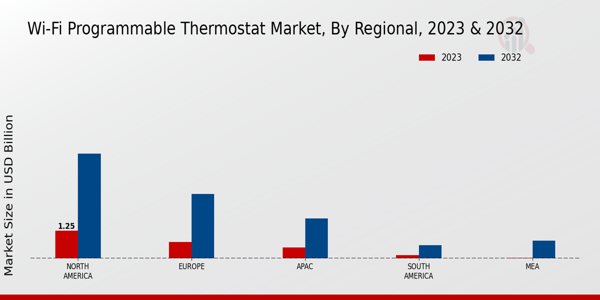Rising Demand for Energy Efficiency
The Global Wi-Fi Programmable Thermostat Market Industry experiences a surge in demand driven by the increasing emphasis on energy efficiency. Consumers are becoming more aware of their energy consumption patterns and are seeking solutions that help reduce utility bills. Wi-Fi programmable thermostats allow users to optimize heating and cooling schedules based on their daily routines, leading to significant energy savings. In fact, studies indicate that these devices can reduce energy consumption by up to 30 percent. As a result, the market is projected to reach 3.56 USD Billion in 2024, reflecting a growing trend towards sustainable living.
Integration with Renewable Energy Sources
The integration of Wi-Fi programmable thermostats with renewable energy sources is emerging as a notable driver in the Global Wi-Fi Programmable Thermostat Market Industry. As more households adopt solar panels and other renewable technologies, the need for efficient energy management systems becomes paramount. Wi-Fi programmable thermostats can optimize energy usage by aligning heating and cooling schedules with renewable energy production, thereby maximizing efficiency and reducing reliance on grid power. This synergy not only supports sustainability goals but also enhances the appeal of these devices among environmentally conscious consumers.
Technological Advancements in Smart Home Devices
Technological advancements play a pivotal role in the growth of the Global Wi-Fi Programmable Thermostat Market Industry. The integration of smart home technology has transformed traditional thermostats into sophisticated devices that offer remote access and control via smartphones. Features such as learning algorithms and geofencing enhance user experience by automatically adjusting temperatures based on occupancy. This innovation not only improves comfort but also contributes to energy savings. As smart home adoption continues to rise, the market is expected to expand significantly, with projections indicating a market value of 17.4 USD Billion by 2035.
Government Incentives for Energy-Efficient Solutions
Government incentives aimed at promoting energy-efficient solutions are a key driver in the Global Wi-Fi Programmable Thermostat Market Industry. Various countries have implemented rebate programs and tax credits to encourage consumers to invest in energy-saving technologies. These initiatives not only lower the upfront costs associated with purchasing Wi-Fi programmable thermostats but also raise awareness about their benefits. As governments worldwide strive to meet environmental targets, the adoption of such devices is likely to increase, further propelling market growth. This trend aligns with the projected CAGR of 15.53% for the period from 2025 to 2035.
Consumer Preference for Remote Monitoring and Control
The growing consumer preference for remote monitoring and control capabilities significantly influences the Global Wi-Fi Programmable Thermostat Market Industry. Modern consumers value convenience and flexibility, and Wi-Fi programmable thermostats provide the ability to manage home temperatures from virtually anywhere. This feature is particularly appealing to busy households and frequent travelers, as it allows for real-time adjustments and energy management. As more individuals seek to enhance their home automation systems, the demand for these thermostats is expected to rise, contributing to the overall market expansion and reinforcing the trend towards smart living.




















Leave a Comment